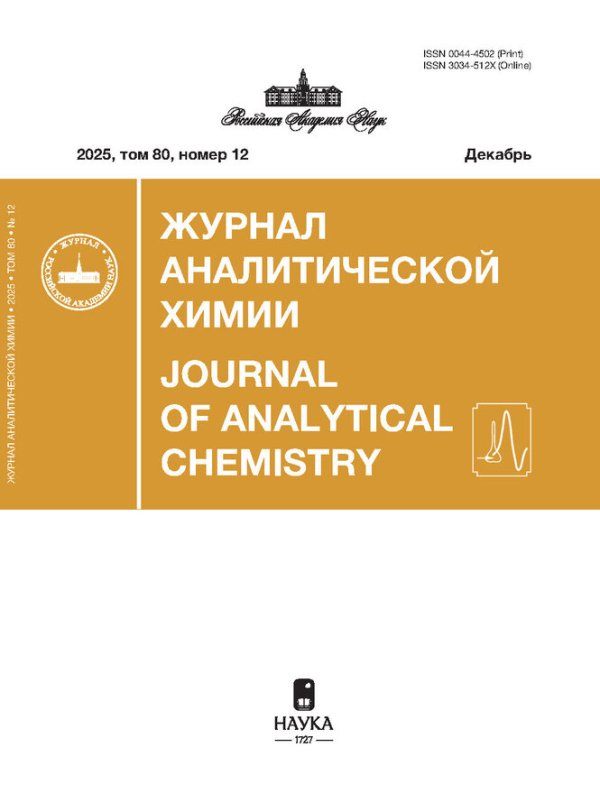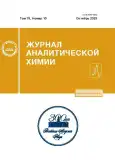Vol 78, No 10 (2023)
REVIEWS
Tunable Diode Lasers for Analytics and Diagnostics
Abstract
Continuous-wave diode lasers (DLs) with tunable emission wavelengths have become extensively used in various fields of analytical spectroscopy and diagnostics. Working in the near and mid-IR spectral region, tunable diode lasers are particularly effective in detecting simple molecules, making them invaluable for environmental monitoring, industrial process control, and diagnostics of subsonic and supersonic gas flows. However, the lack of commercial diode lasers operating in the spectral region shorter than 400 nm has restricted their applicability to elemental analysis, as many resonance lines of free atoms of elements lie in the region 250–400 nm. This review aims to highlight various applications of continuous diode lasers, which are lesser-known to analytical chemists. We briefly overview their main characteristics and discuss their advantages, enabling their successful implementation in traditional analytical spectroscopy tasks, as well as for diagnosing parameters of remote gas objects, including combustion processes in mixing gas flows.
 867-882
867-882


Modern Approaches to the Extraction and Preconcentration of Biologically Active Compounds from Plant Samples by Microextraction Methods for Their Determination by Chromatography–Mass Spectrometry
Abstract
The review considers the main trends in actively developing methods of solid-phase and liquid–liquid microextraction for the extraction, purification, and preconcentration of analytes from medicinal plants and plant materials, the use of new extractants and approaches to the preparation of samples of plant origin, and their compatibility with mass-spectrometric detection. Particular attention is paid to the analytical capabilities, advantages, and limitations of each of the approaches to extracting analytes from plant materials for the subsequent analysis of the obtained extracts by chromatography–mass spectrometry.
 883-896
883-896


Methods of Atomic Spectroscopy in Studying Properties and the Behavior of Nanoscale Magnetic Materials in Biological Systems
Abstract
In this review, we provide an overview of methods for synthesizing magnetic nanoparticles (MNPs) with potential applications to biomedical research. We explore how the structure and properties of these particles are related to their diverse uses in medical diagnostics and bioanalysis. Special emphasis is placed on MNPs containing noble metals, which serve as biomarkers or active agents. Specifically, we focus on the application of direct and combined methods of atomic spectroscopy (ETAAS, AES/ICP–MS) to biomedical research. Experimental approaches to studying the behavior and transformations of MNPs in vitro and in vivo are considered. The importance of proper sample preparation in simulating the behavior of nanoparticles in biological media is highlighted. We also examine the significance of preparation techniques for the accurate determination of dissolved and nanosized forms in biological samples. Lastly, we assess the potential for the comprehensive studies of MNP behavior within complex biological systems, pointing toward future directions in this dynamic and promising field of research.
 897-913
897-913


Specificities of the Fourier Transform Infrared Spectroscopic Methodology and Interpretation of Spectroscopic Data in Microbiological Analyses
Abstract
In this mini-review, some of the most significant, from the authors’ point of view, features of the methodology of Fourier transform infrared (FTIR) spectroscopy and interpretation of experimentally obtained spectroscopic data are considered, as applied to the molecular spectrochemical analysis of microbiological objects using examples published in the specialised scientific literature mainly in recent years. Examples of typical inaccuracies and errors both of a methodological nature and arising in the interpretation of spectroscopic data are also presented and briefly discussed.
 914-928
914-928


ORIGINAL ARTICLES
S,N-Containing Sorbents for Analyzing Rare Earth Element Compounds by Arc Atomic Emission Spectrometry
Abstract
A possibility of using S,N-containing sorbents for the analysis of materials based on rare earth element compounds with the determination of impurities in the sorption concentrate by arc atomic emission spectrometry is studied. The properties of S,N-containing sorbents in aqueous solutions and various rare earth matrices are studied. A methodological approach to the sorption preconcentration of impurities in REE-based materials followed by a direct analysis of the sorption concentrate by arc atomic emission spectrometry is described. The results of the development of a spectrochemical method for determining impurities in rare earth element materials are presented, and performance characteristics are evaluated.
 929-941
929-941


Определение 15 биомаркеров функционального состояния в моче человека методом высокоэффективной жидкостной хроматографии с тандемным масс-спектрометрическим детектированием
Abstract
Обсуждены возможности и ограничения комплексных процедур целевого метаболомного анализа с применением жидкостной хроматографии в сочетании с тандемной масс-спектрометрией (ВЭЖХ-МС/МС). Представлена ВЭЖХ-МС/МС-методика, позволяющая одновременно определять содержание 15 биомаркеров функционального состояния человека в моче. В качестве целевых аналитов выступают биогенные вещества различной химической природы, базовые концентрации которых в биоматрицах могут различаться значительно – до трех порядков величины и более. Сложность комплексного анализа обусловлена также значительными различиями в гидрофильно-гидрофобных свойствах определяемых веществ. Апробация методики в биоаналитическом эксперименте позволила установить значимые различия в концентрациях ряда биомаркеров в моче людей с разным уровнем физической подготовки. При высоком уровне физической подготовки концентрации этих соединений в моче имеют более низкие значения в сравнении с контрольной группой.
 942-952
942-952


Institute of Chemistry, Chernyshevsky Saratov State University
Abstract
New test tools made of nanofibers based on polyamide-6 (PA-6) for the sorption preconcentration of some phenols as their azo derivatives followed by colorimetric determination are obtained. Approaches to the derivatization of phenol and chlorine derivatives by azo coupling with 4-nitrophenyldiazonium and oxidative condensation with 4-aminoantipyrine for improving the sorption characteristics of the studied phenols are proposed. The efficiency of the two derivatization methods is compared. The sorption kinetics of phenol and 2-chlorophenol derivatives and the effect of pH on the nature of their sorption are studied. The features of the sorption of phenol derivatives on nonwoven materials and the corresponding sorption isotherms are interpreted. Examples of the quantitative assessment of the concentration of phenols in aqueous media by the mathematical processing of digital images of the colored areas of test tools are presented. It is shown that the proposed methods can be used for the determination of phenol and 2-chlorophenol with the preconcentration of their derivatives on a PA-6 nanofiber in the range 0.2–1.0 μM (≈0.02–0.09 mg/L for phenol, ≈0.03–0.13 mg/L for 2-chlorophenol) with an error of colorimetric determination of no more than 20% (MAChshld phenol is 0.001 mg/L for the amount of volatile phenols in water bodies, provided that water is disinfected with chlorine; in other cases, the MAC is 0.1 mg/L).
 953-960
953-960













